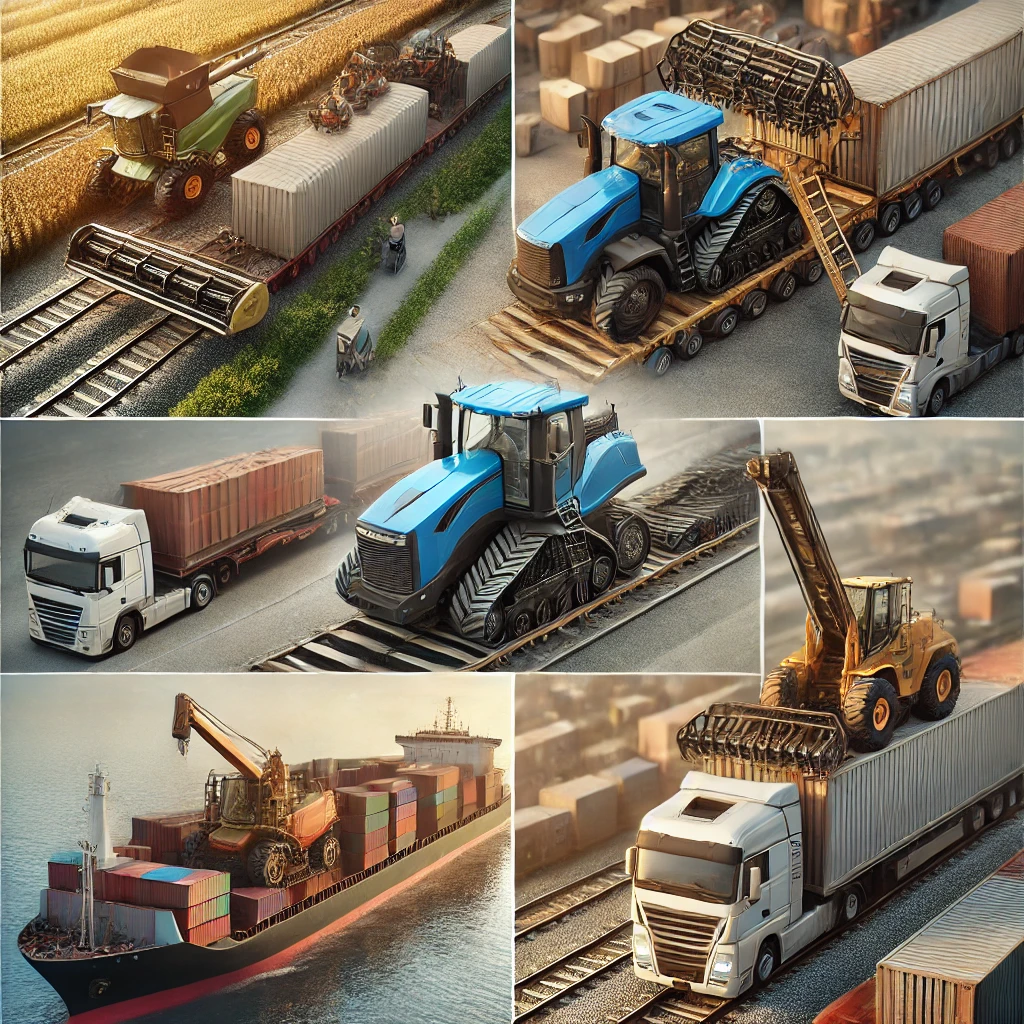In agricultural production, choosing high-performance machinery is important, but ensuring that the equipment is transported safely and efficiently to its destination is just as crucial. Damage, delays, or compliance issues during transportation can disrupt the customer’s work schedule and cause unnecessary problems. As an agricultural machinery supplier, we understand that customers not only need high-quality equipment but also reliable transportation method to ensure timely and safe delivery.
Different transportation methods, such as road, rail, and sea, each have their pros and cons. Choosing the right option based on the type of equipment, delivery time, transportation costs, and other factors is a challenge every customer faces when purchasing machinery. Factors like the size, weight, delivery location, and urgency of the project all influence the final transportation decision.
In this article, we will provide practical steps and a decision-making framework to help customers make informed choices based on their specific needs. With our technical analysis and professional support, you can not only select the right equipment but also ensure it reaches its destination smoothly and safely, avoiding unnecessary delays and extra costs.

Contents
1. Common Issues in Equipment Transportation and Their Solutions
During the transportation of agricultural machinery, customers may face various challenges. Below are some of the main issues and corresponding solutions to help customers avoid these risks and ensure safe and timely delivery of their equipment.
1.1 How to Choose the Right Transportation Method Based on Equipment Size and Weight?
Issue: Agricultural machinery is often large and heavy. How can you choose the right transportation method to ensure the safety of the equipment during transit?
Solution:
Depending on the size, weight, and distance of the transport, different methods can be used. For oversized equipment like large tractors or combine harvesters, sea freight and rail transport are the best options. They have high load capacity, are suitable for long distances, and offer relatively low costs. For smaller equipment or shorter distances, road transport provides a flexible solution, especially for quick deliveries within a region. We will recommend the best transportation method based on your equipment’s characteristics and your needs, ensuring the equipment arrives safely and undamaged.
1.2 How to Balance Transportation Time and Costs?
Issue: Transportation time and costs often affect each other. How can you control costs while ensuring timely delivery?
Solution:
To plan transportation efficiently, you need to choose the right method based on delivery urgency and budget. Sea freight is the most cost-effective option, typically 30%-50% cheaper than rail or road transport, making it ideal for non-urgent deliveries. However, sea freight takes longer, often requiring several weeks to reach its destination, so it’s better for projects that don’t need quick delivery. Rail transport offers faster delivery for long distances, with moderate costs, usually 15%-20% higher than sea freight but 10%-30% cheaper than road transport. Road transport is flexible and fast, especially for short distances, but tends to be more expensive, generally 20%-40% higher than rail. We can help you create the best transportation plan based on your delivery timeline and budget, ensuring your equipment arrives on time without exceeding costs.
1.3 How to Minimize Risks During Transport and Ensure Equipment Safety?
Issue: Long-distance transportation may pose risks such as damage or delays. How can you ensure the safety of the equipment during transport?
Solution:
Agricultural machinery is often large and fragile, so choosing a safe and reliable transport method is key to ensuring that the equipment arrives intact. We recommend that customers work with logistics companies that provide real-time tracking and insurance services, allowing for continuous monitoring during transport and reducing the risk of damage. Additionally, we have strong partnerships with several logistics companies that specialize in transporting agricultural machinery, helping you select the right provider to ensure a smooth process and minimize delays.
1.4 How to Ensure Compliance with Transport Regulations?
Issue: Particularly in international transportation, equipment must comply with various legal regulations. How can you ensure the transport complies with these regulations?
Solution:
Cross-border transportation involves complex regulations and paperwork. We work with international logistics providers to ensure that your equipment complies with import and export laws in each country. We will handle all documentation, including customs duties and import compliance, allowing your equipment to pass inspections smoothly. This not only prevents delays but also ensures that deliveries to different markets are successful.
2. Key Steps for Planning Equipment Transportation Scientifically
By following these key steps, you can plan the transportation of your equipment efficiently, ensuring safety, timely delivery, and cost control.
2.1 Assess Transportation Needs
First, you need to evaluate the appropriate transportation method based on the weight, size, delivery time requirements, and the transportation route of the equipment. For large equipment (like combine harvesters), sea freight or rail transport are ideal options, while medium-sized equipment can be moved using more flexible road transport. We will provide detailed transportation recommendations based on your specific needs and the characteristics of the equipment, helping you choose the best method.
2.2 Balance Transportation Time and Costs
Balancing transportation time and costs is crucial in planning. For non-urgent equipment, sea freight is a cost-effective option. For equipment that needs quick delivery, rail transport can ensure faster speeds while keeping costs under control. We will design a transportation plan that fits your project schedule and budget, ensuring your progress remains uninterrupted.
2.3 Real-Time Monitoring and Risk Prevention
Real-time monitoring of equipment during transport is essential to ensuring its safety. We offer real-time tracking services, allowing you to stay updated on the progress of your equipment’s journey. With this service, you can always know the location of your equipment and ensure that the transportation stays on track. For international shipments, we also recommend purchasing transport insurance to handle unforeseen events and reduce risks.
3. Real-Life Case Studies: Ensuring Safe Delivery Through Efficient Transportation Solutions
Case 1: Efficient Rail Transport for a Combine Harvester
An agricultural cooperative imported a large combine harvester from Eastern Europe and needed to transport it to a farm in Western Europe. We helped the customer choose a rail transport solution and assisted them with all cross-border transportation documents. Using our real-time tracking service, the customer was able to monitor the equipment’s transportation status at all times, ensuring it was delivered on schedule and successfully put into use. This solution saved the customer 25% on transportation costs.
Case 2: Efficient Road Transport for a Tractor
A farmer needed to transport a tractor from a local warehouse to a remote farm. We planned a road transport solution and worked with local logistics companies to ensure the equipment was delivered within two days. During the transport, the customer used our tracking system to stay updated on the progress, and the tractor was put to work immediately upon arrival, ensuring the farm’s operations continued smoothly.
Conclusion:
Ensuring Safe and Efficient Equipment Delivery Through Strategic Planning
No matter how complex the transportation needs are, careful planning is key to ensuring the safe and efficient delivery of equipment. As a supplier of agricultural machinery, we not only provide high-quality equipment but also help customers create optimal transportation plans to ensure timely and secure delivery.
Perfect Combination of Technology and Logistics
Our transportation solutions integrate both the technical needs of the equipment and high-quality logistics services, ensuring you can control costs while improving delivery efficiency. Whether it’s long-distance transportation of large machinery or flexible local delivery, we offer personalized solutions to meet your needs.
Comprehensive Service and Risk Management
We provide full logistics support, combining real-time monitoring and risk management to ensure the safety of your equipment during transport. With our insurance and tracking services, you can trust that your equipment will be protected and achieve maximum productivity.

